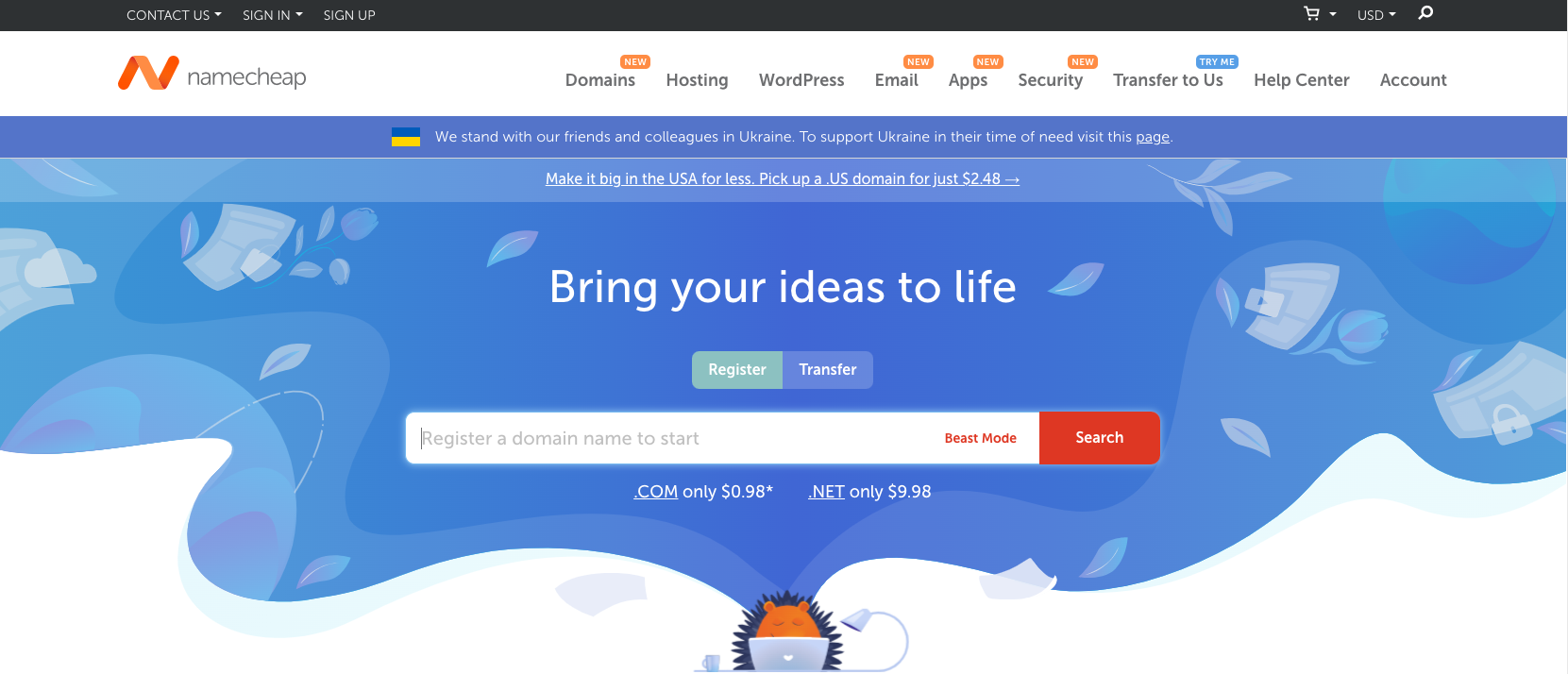Table of Contents
- Anatomy of a Domain Name
- Top Level Domains (TLDs)
- Selecting a domain name
- Registering a domain name
- Managing your domain name registration
Domain names have been called “the real estate of the Internet”. While it may not be a physical location, it is effectively your address on the world wide web. Choosing the right domain name, and taking proper care of its registration, are essential for maintaining this presence. If you’re responsible for a website, this article will tell you everything you need to know about domain names.
Note: If you already have a domain name, and you’re more interested in proper stewardship of your existing domain name registrations, you can skip right to the Managing your domain name registration section below.
Anatomy of a Domain Name
There are two or more parts to a domain name:
- The top level domain (like .com or .org). Somewhat confusingly, the “top” part means that it goes at the end of the domain name.
- The second level domain (such as google or microsoft). The top and second level together comprise the domain name that we’re all familiar with, like
google.comormicrosoft.com. - Optionally, there can be a third level, such as
mail.google.com, known as a subdomain. There may even be additional levels, likea.d12.mail.google.com. If you’re the registration holder for a domain name, you can create as many subdomains as you want.
Top Level Domains (TLDs)
.com top level domain
By far the most popular and familiar top level domain is .com. If you’ve been on the Internet for any length of time, you’ve become so accustomed to it that you’ve probably used it accidentally a few times when looking for a website that isn’t actually located in the .com namespace.
The .com namespace is very old, dating back to the mid 1980’s. As such, is highly saturated with registrations, and it can be challenging to find an available domain name at this level.
.net and .org top level domains
.net was originally intended for Internet Service Providers, and .org was originally intended for non-profit organizations and other non-commercial entities. However, over the last 20 years these associations have become substantially blurred. These days anyone can register a .net or a .org domain name, and they’re no longer synonymous with their original purposes.
Specialty top level domains
There are a wide variety of specialty TLDs that have proliferated in recent years. Some popular examples have been outlined below, or you can browse this full list of top-level domains on Wikipedia.
| TLD | Description (Source: Wikipedia) |
|---|---|
| .info | The name is derived from information, although registration requirements do not prescribe any particular purpose. |
| .biz | Intended for registration of domains to be used by businesses. The name is a phonetic spelling of the first syllable of business. |
| .pro | Derived from professional, indicating its intended use by certified professionals. |
| .travel | Available to individuals and / or organizations who provide or plan to provide services, products or content in or to the travel industry. |
| .agency | Marketing and advertising agencies, PR or communications agencies, design firms, talent agencies, travel agencies, other related agencies. |
| .build | For businesses in the construction industry. |
Country top level domains
Most countries around the world have their own top level domains. For example, Australia has .au, Brazil has .br, and China has .cn.
As a general rule, you must have a physical or legal presence in the associated country in order to register a name under its TLD. For example, In order to register a .br domain, the registrant must be a citizen, resident, or other entity legally established in Brazil, and in possession of a Brazilian tax identification number.
However, this isn’t universally the case. For example, the .io top level domain is associated with the British Indian Ocean Territory, but anyone can register a .io domain. As a result it has become a popular choice for technology-oriented websites due to its resemblance to “input-output”, a common technical phrase.
When in doubt, you’ll need to research the registration requirements for the specific country or countries you’d like to establish a presence in.
Selecting a domain name
What is the best choice for a top level domain?
If you do business exclusively in a single country or small set of countries, it may be a good idea to use a country-level TLD, however the right choice here varies from place to place. For example, Canada’s .ca TLD is quite popular, and virtually all Canadians are familiar with it. If you and your customers are located in Canada, a .ca domain is an excellent choice. On the other hand, in the United States the .us TLD is not nearly as popular with American citizens, due in large part to that country’s role as the inventor of the Internet itself, where .com is the de facto standard for commercial enterprises.
.org is still somewhat popular amongst non-profits, and can be a good choice if the scope of your non-profit organization is global in nature.
The desirability of .net domain names has diminished substantially. If you’re thinking about a brand new domain name, it’s generally not advisable to register a .net domain. Few people will remember these, and memorability is important.
If your customers are located around the world, you’ll be best off going with a .com domain, or with one of the specialty TLDs outlined above. In general, if you can find an available .com domain name, go with that as your first choice. You’ll have the least amount of friction
Searching for available domain names, the safe way
You should absolutely not search for domain names by typing them into your browser to see what happens – that can be dangerous. You never know what’s on the other side of a random domain name. You may find yourself looking at ad-infested pages or worse, and there may even be attempts to download malware to your computer. But most importantly, even if nothing comes up, it doesn’t actually mean the domain is available. It may simply mean that the domain’s registrant hasn’t set up a website yet.
So how do you search for available domain names safely? Your best bet is to visit a reputable registrar like NameCheap. These websites have lookup tools that allow you to safely search for available domain names.

Frequently Asked Questions
Q: Should I register multiple domain names?
A: If you own a country TLD like .ca, it’s a good idea to register the .com version as well, if it’s available. Lots of people will forget your TLD and will just add .com into their browsers or email programs. You’ll do these folks a huge favour by anticipating their mistake and redirecting them to your primary domain automatically. However, it’s not necessary to purchase the .net, .org or other TLD variations of your domain name.
Q: What if someone registers an alternate version of my domain name and uses it to steal my customers or ruin my reputation?
A: While it’s common for big multi-national brands to register dozens or even hundreds of variations of their official brand names as a defensive measure, in practice it’s not necessary for small to midsize businesses. Cases of sabotage or smear campaigns are exceedingly rare.
Q: Should I buy a domain that is for sale?
A: You may find a desirable domain name that is being offered for sale. The internet is full of speculators (known as ‘squatters’) who register domain names in the hopes of being able to resell them at a substantial profit. The decision of whether or not the price being asked is worth it or not is ultimately up to you. However, if you do decide to purchase a domain name, it’s best to do so directly through a reputable registrar, or an experienced technical professional, who can safely broker the deal.
Registering a domain name
Who should manage your domain registrations?
If you’re a sole proprietor or leading a very small organization, you personally are probably the best person to manage your domain name registrations. At that size, your company’s most reliable point of continuity is you. Turnover in staff, as well as changes to external service providers are much more common in tiny companies.
For organizations a bit larger than this, it’s best to assign this task to a trusted technical partner. Your Internet Service Provider can be a good choice if their other services are reliable, and if their customer service is good. Many ISPs offer this as a value-added service. If you outsource your IT to a managed services provider and they’ve been around for awhile (10+ years), they’re likely to have decent processes in place for managing domain names.
At Elev8 Web Studio, we handle domain registrations on behalf of our customers, and have the supporting processes in place to ensure their proper stewardship and management.
Choosing a domain registrar
If you’ll be self-managing your domain name registrations, we recommend a reputable registrar like Namecheap or GoDaddy. If you’re outsourcing this to a trusted technical partner, let them recommend a service. They’ll already have a preferred registrar that they trust. At Elev8 Web Studio, we use Amazon Route 53, but it is optimized for service providers, and isn’t the right choice for self managed domains.
Information you’ll need to register a domain
Before you register a domain name, you’ll need the following information on hand:
- Contact details for the primary registration contact.
- First and last name – The primary registration contact should be a real person. “Finance Department” is generally not acceptable for use in a domain contact record.
- Physical address – Including country and postal/ZIP code.
- Email address – Use an email address that is likely to be accessible over the long term (Gmail, Yahoo Mail and Hotmail are generally OK, provided you check them regularly). Don’t use an email address given to you by your Internet Service Provider, because if you change providers, you could potentially lose access to your domain registration.
- Optionally, similar contact details for the administration contact and technical contact.
The primary contact record
The primary registration contact is the most important contact record for your domain name registration, so it’s the most critical to get this part right.
If you’re the sole proprietor and website owner, this contact should be you personally.
For businesses and non-profits, someone in a senior position directly from the organization itself is the best option. Note that this doesn’t necessarily have to be the CEO, or an Executive Director in the case of non-profits. In some organizations there is substantial turnover in leadership positions, and the most stable registration contact might be the head of Finance, or even the office manager who’s been there longer than anyone else.
This contact record should never be your website developer, an outsourced IT company or your Internet Service Provider. This means that they own the registration, not you.
The administrative contact record
The administrative contact is a secondary contact that is authorized to make administrative changes related to the domain name, such as updating the contact records themselves.
This is an optional contact record. In cases where it is required, it can be the same person as the primary registration contact.
The technical contact record
This record designates a person who is authorized to make technical changes related to the domain name. For example, modifying the authoritative DNS servers would be handled by the technical contact.
This is an optional contact record. In cases where it is required, it can be the same person as the primary registration contact.
Should I register for one year or multiple years?
Although domain registrations are renewed on an annual basis, you can also purchase multiple years at once. Some top level domains will allow you to register for as many as 10 years up front. Purchasing multiple years in advance can save you the hassle of the annual renewal process. Although this sounds convenient, we recommend registering domain names for only a single year at a time, and renewing them each year.
Multi-year registrations have a much higher risk of ending up with out of date contact records. Stale registration contact records always cause problems, but they’re particularly bad when the contact is long gone and may no longer be reachable or cooperative.
A great example of this is the director who left 3 years back, moved across the country, and doesn’t have access to the original email account referenced in the registration anymore. Or the solo IT consultant who quit freelancing and won’t respond to requests for help. Both of these are real scenarios we’ve seen play out many times before. If the previous domain registration contact left only a few months ago, you’ve got a better chance of correcting the problem while it’s still relatively fresh.
Managing your domain name registration
The registration renewal process
Each year, your domain registration must be renewed. Your registrar will send an email reminder in advance of the renewal date, generally 4 to 6 weeks out. This reminder message should be your cue to review the registration contact details to ensure they are accurate and up to date. This is the best time to identify any issues, and to correct them.
Most registrars keep your credit card details on file, and will automatically process the renewal each year, but it’s still important to pay close attention to these reminder messages when they arrive. Many domain names are nearly lost when there is a payment problem, and the alert messages are ignored.
If you do miss all of the warnings, and your domain name expires without payment, you’ll know it pretty quickly. Your website, email, and any other services connected to your domain name will go offline. You’ll be frantically calling your IT team or web host or ISP (or all of these) to find out what’s going on, and it’ll usually take a bit of investigation to uncover the root cause.
Fortunately, there is a brief grace period for most top level domains during which you can reclaim your domain name registration and bring your services back online. This period is typically 30 days, but sometimes it is substantially less. Here’s a handy reference on domain redemption grace periods from Namecheap. There may also be re-activation fees and other costs associated with domain recovery: these situations tend to cause a bit of a mess that needs expert cleanup.
Maintaining domain contact records
The importance of maintaining the accuracy of the contact records for your domain registrations can’t be overstated. As one of your most important digital assets, you need a process for keeping this information up to date. If you’ve followed our advice to register your domain name for only one year at a time, then the annual renewal cycle is a great opportunity to review these details.
Conclusion
As a foundational element of your digital presence, a working understanding of domain names is essential for any website owner. By following the best practices outlined in this article, you’ll be fully equipped to manage your domain name registrations well.


